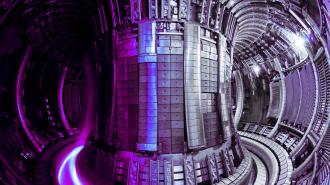Scientists in the UK have set a new world record for generating energy from nuclear fusion — and the device that did it is about to be shut down.
The road to fusion: Nuclear fusion is a holy grail of energy research. If we can figure out a way to reliably harness the energy that’s released when two atoms merge, we’d have a near-limitless source of clean energy.
The problem is that nuclear fusion only happens under tremendous pressure and heat — like the conditions at the center of the sun. Creating (and maintaining) those conditions here on Earth is a huge engineering challenge, and we can’t yet get more energy out of the fusion reaction than it takes to create it.
“Its legacy will be pervasive in all future powerplants.”
Ian Chapman
Experiments like the Joint European Torus (JET), a fusion research facility owned by the UK Atomic Energy Authority (UKAEA) and managed by EUROfusion, are getting us closer, though.
JET was the first nuclear fusion reactor to run on a combination of tritium and deuterium — the fuel mix that would likely be needed to power any commercial fusion power plant — and in 2021, it set a world record by generating 59 megajoules of heat energy from fusion.
What’s new? The UKAEA has now announced that JET broke its own record during a December 2023 experiment, generating 69 megajoules of heat energy over five seconds (as was the case in 2021, the experiment still required more energy than it generated).
“This world record is actually a by-product. It was not actively planned, but we were hoping for it,” said Athina Kappatou, a JET researcher from the Max Planck Institute for Plasma Physics. “This experimental campaign was mainly about achieving the different conditions necessary for a future power plant and thus testing realistic scenarios.”
End of an era: Aside from setting a new record, the December test was also noteworthy for being JET’s final experiment before decommissioning. That doesn’t necessarily mean we’ve learned all we can from this historic nuclear fusion reactor, though.
“As anybody who’s taken something like an old car to bits will know, the process of unbolting and disconnecting things just leads you to understand it a whole lot more than you did when it was operating, and we can learn things, I think from pulling apart JET,” said Paul Methven, CEO of UK Industrial Fusion Solutions.
While some are focusing on taking JET apart, others will continue work on building its larger, more powerful successor: the International Thermonuclear Experimental Reactor (ITER). That device is already under construction in France and expected to achieve “first plasma” in 2025.
“JET has operated as close to powerplant conditions as is possible with today’s facilities, and its legacy will be pervasive in all future powerplants,” said Ian Chapman, UKAEA’s CEO. “It has a critical role in bringing us closer to a safe and sustainable future.”
We’d love to hear from you! If you have a comment about this article or if you have a tip for a future Freethink story, please email us at [email protected].






